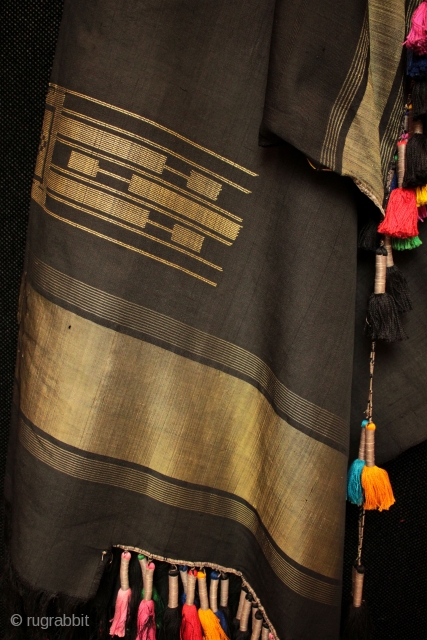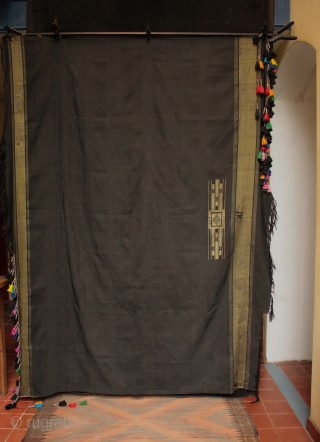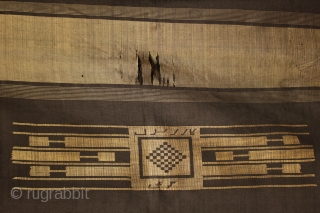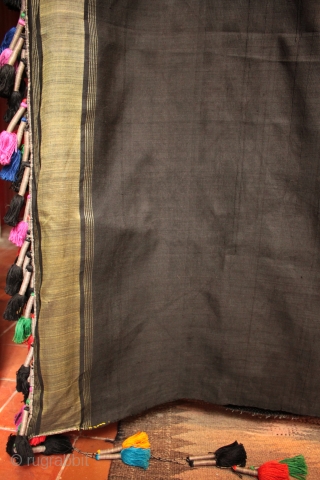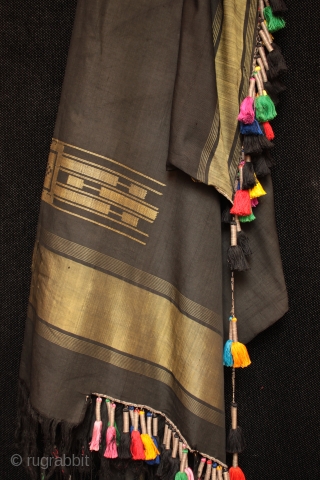For photos of this type of black and gold silk shawl/head dress being worn by elderly Rishwan women, the last generation to wear it, please see this link: https://www.facebook.com/kilim.ie/posts/737548073005124?pnref=story
From a collection of antique Syrian shawls and other textiles acquired in Turkey in September, a hand loomed 19th century woman’s silk shawl/head dress with gold bands and weavers inscription. The shawl called a ‘Şar’ or ‘chit’ was a very expensive garment worn by high status women of the Rishwan (or Reshwan) tribe in the Adiyaman area of East Anatolia and was made to be worn over an abba street dress. This example has metal bound tassels added in the 20th century. The central gold saf-like motif is the master weaver’s workshop ‘logo’ and below this is the signature of the weaver "Kaar" (the work of) "Rassoul Karaki". The more gold thread used in weaving the shawl, the higher the status of the woman wearing it. (Thanks to Deniz Coşkun for information on the name and tribal origin and to Camille Khairallah for his translation).
According to ‘The Arts and Crafts of Syria: Collection Antoine Touma and the Linden-Museum Stuttgart’ by Johannes Kalter (1992)
‘Depending upon their method of manufacture they are called kasrawaniyye or homsiyye. The cloths are square and vary in size from 1.10 to 2.40 meters. They are woven from heavy silk (black or red) and their distinguishing feature consists of patterns woven in gold or silver threads. The cloths end in long knotted fringes.’ Although these are called ‘Aleppo’, the book says they were woven in Homs. (Reference thanks to Tim Hays).
The black silk is in very good condition, although as often found on antique Syrian silk shawls using silver and gold thread, there are stains to the gold bands and some separation of the silk weft where it was worn over the head (see last two photos in link below). The central woven gold motif and inscription is the master weaver’s ‘logo’ and name (photo 3). Size 240cm x 160cm.
For more photos see: http://www.kilim.ie/TRIBAL_ART_AND_ANTIQUES/Pages/19th_C._Syrian_Homs_Si...
Please contact me more more information.
- Home
- Antique Rugs by Region
- Category
- Profiles
- Post Items Free
- Albums
- Benaki Museum of Islamic Art
- Budapest: Ottoman Carpets
- Gulbenkian Museum
- Islamic Carpets. Brooklyn
- Islamic Textiles. Brooklyn
- Konya Museum: Rugs
- MKG, Hamburg
- MMA: Caucasian Carpets
- MMA: Mamluk Carpets
- MMA: Mughal Indian Carpets
- MMA: Ottoman Carpets
- MMA: Safavid Persian Carpets
- MMA: Turkmen Rugs
- McCoy Jones Kilims
- Ottoman textiles. Met
- Philadelphia Museum
- Rugs and Carpets: Berlin
- Seljuqs at the Met
- TIEM, Istanbul: Carpets
- V&A: Classical Carpets
- Vakiflar Carpets: Istanbul
- Baluch Rugs: Indianapolis
- Gallery Exhibitions
- Jaf an Exhibition
- Alberto Levi Gallery
- Andean Textile
- Christie's London: 2016
- Francesca Galloway
- HALI at 40
- ICOC Washington, DC 2018
- Jajims of the Shahsavan
- London Islamic Week April, 2018
- Mongolian Felts
- Navajo Rugs: JB Moore
- Persian Piled Weavings
- SF Tribal & Textile Art Show 2020
- SF Tribal 2019
- Sotheby's: C. Alexander
- Turkish Prayer Rugs
- Turkmen Main Carpets ICOC 2007










